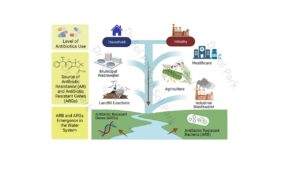Tracking the Source and Anthropogenic Effects of Antibiotic Resistance Genes (ARGs) in the U.S. Water System
The emergence and spread of antibiotic resistance (AR) are one of the greatest global public health issues of the 21st century. Antibiotic resistance (AR) challenges therapeutic potential against pathogens of humans and animals. Howbeit, AR is an ongoing pandemic that is unnoticed by many. The increase of AR in a broad range of microorganisms is linked to the indiscriminate use of antibiotics. Nowadays, there are frequent reports of the occurrence of ARB and ARGs in rivers, soils, treated drinking water, sewage, and air. the overall ARG distribution, and quantification throughout three different water systems across the U.S. The definition used as “water system” refers to a set of different water body types such as a river, lake, wetland, underground aquifer, including effluents of wastewater treatment plants.
Degradation of Antibiotic Resistance Genes using Hydroxyl Radical and Sulphate Radical
Predictably, the environment has been implicated in the widespread of AR in clinical settings. Wastewater treatment plants (WWTPs) are considered major sources for the release of antibiotic resistant bacteria (ARB) and antibiotic resistance genes (ARGs) into the environment. Moreover, AR in water may contribute to AR in food as water reuse becomes popular. In this regard, effective wastewater treatment can serve as a barrier against the release of ARB and ARGs into the environment. Advanced oxidation processes (AOPs) that utilize the strong oxidizing power of hydroxyl radical and sulphate radical as promising technologies for ARGs degradation.
Inactivation of Antibiotic Resistance Bacteria using Photo-Activated Silver Nanoparticles
Addressing AR threats involves eliminating the development of new resistant traits by developing alternative antimicrobials with novel non-specific low-mutation bacterial targets. In recent years, great attention has been directed to the use of antimicrobial nanoparticles (NPs) as alternative antimicrobials with novel non-specific low-mutation bacterial targets Antimicrobial NPs inactivate microorganisms via non-specific pathways with multiple targets involving a combination of cell membrane lysis and ROS generation to degrade cellular compounds
 |
 |
| Sources of Anthropogenic ARGs Sources | AOP Degradation Kinetic Study |
